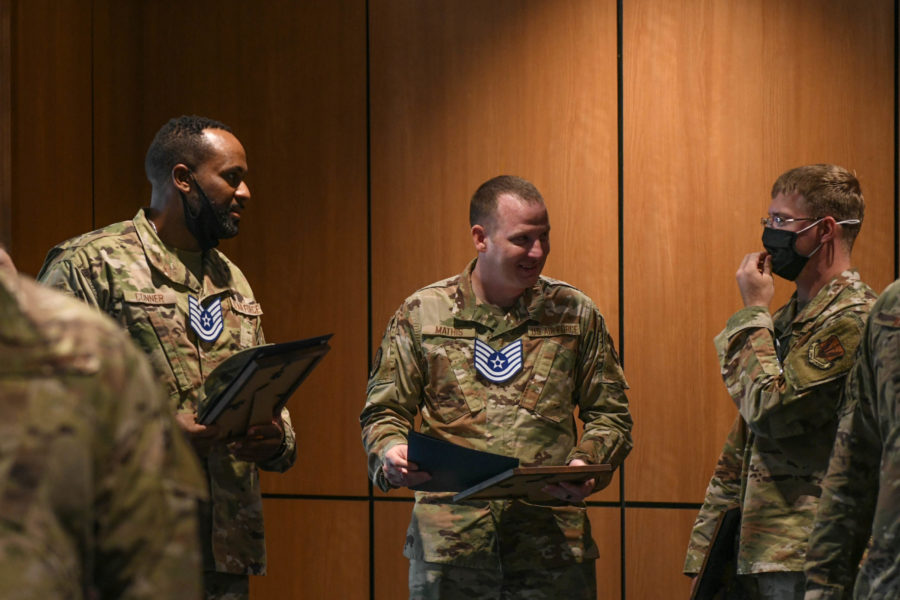A few days after warning that promotion rates for enlisted noncommissioned officers were likely to drop over the next several years, the Air Force Personnel Center announced the statistics from the 22E6 Air Force promotion cycle July 12—with the fewest number of Airmen getting promoted to technical sergeant in at least a decade.
All told, 5,430 staff sergeants were tapped to become tech sergeants, AFPC said in a release. The full list of those promoted will be released on myPers 8 a.m. Central time July 20.
The total number of those promoted represents a dramatic decline from 2021, when 9,422 Airmen were selected. At least 7,500 staff sergeants had been selected in each of the previous seven years, and even in leaner years such as 2014 and 2013, at least 5,500 Airmen were promoted. Air Force Magazine could not immediately confirm statistics from before 2012.
The lowest promotion rate for E-6s this decade still belongs to 2013—5,654 were selected out of 37,608, for a rate of 15.03 percent. By comparison, the 2022 cycle had 33,935 eligible candidates, making for a promotion rate of 16 percent.
From 2015 on, though, promotion rates for technical sergeant stayed consistently above 20 percent, sometimes exceeding 30 percent.
But such numbers are unlikely in the near future, the service has warned, as a result of high retention amid the COVID-19 pandemic, end strength numbers plateauing, and recent enlisted grade structure revisions.
In particular, leaders say the grade structure revisions were necessary to combat a decline in experience among Airmen in the NCO corps.
“The majority of the experience decline was attributable to the Air Force trying to achieve an enlisted force structure with too many higher grades,” Col. James Barger, Air Force Manpower Analysis Agency commander, said in a statement. “We also found that experience levels would continue to decline unless the Air Force lays in more junior Airmen allocations and fewer E5-E7 allocations.”
The goal, Barger said, is to reach a “healthier” distribution of Airmen across grades by fiscal 2025—seemingly indicating that lower promotion rates could continue for another two or three years. The service has already announced its lowest E-7 promotion rate in years—14.8 percent for 2022, down from 18.9 percent the year before and a decade-high of 29.6 percent in 2018.
AFPC noted in its release on E-6 promotions that this is the first cycle that incorporated the Promotion Recommendation Score. The new system, introduced in October 2021, is intended to better reward experience by getting rid of weighted scores for Enlisted Performance Reports, instead offering additional points for up to two older EPRs while still placing the most emphasis on the most recent one.
Potential E-6s this cycle also faced a new Promotion Fitness Examination for the first time. In December, the Air Force announced it was switching the test from 100 knowledge-based questions to 60 knowledge questions and 20 “situational judgment test” questions.
A number of other changes are being implemented to Air Force personnel management, such as the introduction of the Airman Leadership Qualities and their incorporation into feedback forms.
Air Force E-6 Promotion Rates Over the Years
| YEAR | SELECTED | ELIGIBLE | PROMOTION RATE |
| 2022 | 5,430 | 33,935 | 16.00 |
| 2021 | 9,422 | 34,973 | 26.94 |
| 2020 | 8,246 | 28,358 | 29.08 |
| 2019 | 9,467 | 29,328 | 32.28 |
| 2018 | 8,416 | 27,555 | 30.54 |
| 2017 | 8,167 | 25,552 | 31.96 |
| 2016 | 7,501 | 33,569 | 22.35 |
| 2015 | 8,446 | 35,863 | 23.55 |
| 2014 | 6,684 | 38,344 | 17.43 |
| 2013 | 5,654 | 37,608 | 15.03 |
| 2012 | 8,518 | 37,402 | 22.77 |
